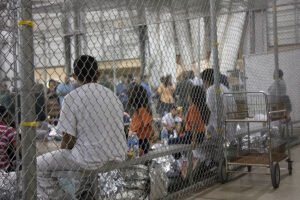
As of 2022, an estimated 4.4 million people in the United States had lost their right to vote due to felony convictions. This is equivalent to the population of Kentucky or Oregon. A report published in June by Human Rights Watch, The Sentencing Project, and the American Civil Liberties Union’s Voting Rights Project seeks to challenge this common practice.
The report—Out of Step: US Policy on Voting Rights in Global Perspective, authored by a nine-person team led by Nicole Porter, senior director of advocacy at The Sentencing Project—examines the laws of 136 countries worldwide with populations greater than 1.5 million people.
Crime disenfranchisement laws in the United States date back to the end of the Civil War.
Of these, 73 rarely or never deny a person the right to vote for a criminal conviction, and 35 never deny the right to vote based on criminal status. Among those 35 are Canada, Denmark, Finland, Ireland, South Africa, Spain, Sweden, and Taiwan.
So, how did so many US states come to deny millions the right to vote? And how can this change? Those are key questions for the report authors.
Racist Roots of Disenfranchisement Laws
Perhaps unsurprisingly, state voting rights can vary wildly. As Porter tells NPQ, “On the low end in the United States, people can be convicted of felonies when it comes to certain administrative offenses such as financial fraud and drug possession.” She adds, “There are several states…where people are disenfranchised for life.”
But Porter notes that on “the opposite end of that, there are several jurisdictions within the United States where people never lose their right to vote because of a felony conviction. That includes two states…Maine and Vermont. And it also includes two territories: Puerto Rico, which expanded voting rights to people completing their prison sentences in the 1980s, and the District of Columbia, which expanded voting rights to people completing their felony sentences in prison a few years ago in 2020.”
These kinds of crime disenfranchisement laws in the United States date back to the end of the Civil War. After formerly enslaved Black men gained the right to vote through the Fifteenth Amendment to the US Constitution, state lawmakers began expanding the list of felonies to target the African American population.
At the same time, states began revoking voting rights for any felony conviction. Although the federal government outlawed some “Jim Crow laws” through the Voting Rights Act of 1965, felony disenfranchisement laws remain on the books in 48 states.
Persistent Disenfranchisement
Black Americans continue to be disproportionately arrested, incarcerated,
and subjected to harsher sentences, including imprisonment without parole. Jonathan Topaz, a staff attorney at the ACLU Voting Rights Project—and another report author—also spoke with NPQ. He explains that “it was a very conscious effort by the White majority at that time to re-disenfranchise Black folks.”
Topaz adds that “criminal disenfranchisement was one of the mechanisms along with things like poll taxes and literacy tests that were designed, again, to limit the political power of newly enfranchised Black folks.”
The impact on the Black electorate was and is significant. Currently, the report indicates that one in 19 Black Americans of voting age is disenfranchised at a rate 3.5 times that of people who are not Black. Nationally, 5.3 percent of Black adults in the United States are disenfranchised, compared to 1.5 percent of the adult population that is not Black. More than one in 10 Black adults are disenfranchised in seven states—Alabama, Arizona, Florida, Kentucky, South Dakota, Tennessee, and Virginia.
More than one in 10 Black adults are disenfranchised in seven states.
Sign up for our free newsletters
Subscribe to NPQ's newsletters to have our top stories delivered directly to your inbox.
By signing up, you agree to our privacy policy and terms of use, and to receive messages from NPQ and our partners.
But not only the Black American community is affected. At least 506,000 Latinx Americans, or 1.7 percent of the voting-age Latinx population, are also disenfranchised.
As Brian Miller, executive director of Nonprofit Vote, described to NPQ, “There are people of color much more likely to be impacted by the justice system, often incarcerated or incarcerated at notably higher rates. And the impact of that is that if you also couple that with a rule that prohibits ex-felons or people with criminal records from voting, then you’re getting a double whammy. Not only the racially disparate impact on incarceration, but also a racially disparate impact on people’s right to vote.”
The organizations dedicated to promoting the right to vote for people with criminal records found that in recent years, some US jurisdictions have taken steps to restore voting rights. Most states no longer disenfranchise people for life, and many allow people released from prison to vote.
This is the case of Florida, which, in 2018, passed an amendment reforming the 150-year-old constitutional text. This amendment restored voting rights to ex-convicts, excluding those convicted of murder and serious sexual offenses.
Before the amendment, Florida was only one of four states in the union that automatically and permanently revoked the right to vote of anyone convicted of a felony. However, subsequent action by the state legislature effectively negated the constitutional amendment, and an estimated 900,000 Floridians are still denied the right to vote.
There are currently two states, Iowa and Kentucky, where voting rights for former prisoners can only be restored through an individual petition or application to the state government.
Legal restoration is only one step toward full restoration. In many states, such as Florida, citizens who rejoin society can only vote after paying various legal financial obligations, essentially creating a system of paying to vote. “This policy of disenfranchising folks for basically inability to pay these fines, fees, and costs is pretty astonishing….Lots of states seem to condition the right to vote on your ability to pay, which is really anathema to democratic values and principles,” says Topaz.
Globally, the trend is toward greater inclusion of people with criminal records—with voting rights protected in a growing number of countries.
Misinformation from election officials about legal reforms has also hindered voter registration. As Porter explains, there is “a lack of information from formal government agencies that notify people of changes in laws, and even a lack of understanding by officials themselves. Other barriers are the fact that for eligible incarcerated voters, the logistics of being registered to vote, having accurate voter registration information so they can access their ballot leading up to the election cycle is also a significant barrier.”
International Trends
Globally, the trend is toward greater inclusion of people with criminal records—with voting rights protected in a growing number of countries. For example, in 2014, Egypt repealed a sweeping law that indefinitely banned anyone convicted of a crime from voting. In 2020, Uganda’s Supreme Court upheld the constitutional right to vote for all citizens over 18, including incarcerated people.
In 2022, Tanzania’s Supreme Court declared unconstitutional a law that disenfranchised people sentenced to more than six months in prison, saying it was too broad and inconsistent with the country’s constitution. That same year, the Chilean government removed voting barriers for detained people, allowing them to vote in the 2022 and 2023 constitutional referendums.
Broader Implications
The right to participate in the conduct of public affairs, which includes the right to vote and to be elected, is at the very heart of democratic governments based on the will of the people, according to the United Nations. Genuine elections are necessary and fundamental components of an environment that protects and promotes human rights.
As Miller explains, even public safety benefits from increased access to the polls: “There are studies that have shown that when people start voting, there’s a recognition that they’re part of the community and that the likelihood of them reentering the criminal justice system is notably lower. If you permanently disenfranchise someone, you’re permanently putting them on the fringe and the chances of them reentering the justice system is higher.”
Miller points out that even if the motivation is not about enabling full civic participation and instead is narrowly focused on reducing crime, “we should be allowing folks to fully participate in the democratic process.”











